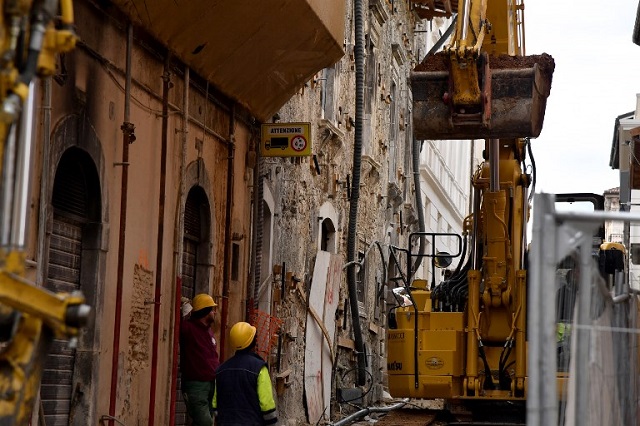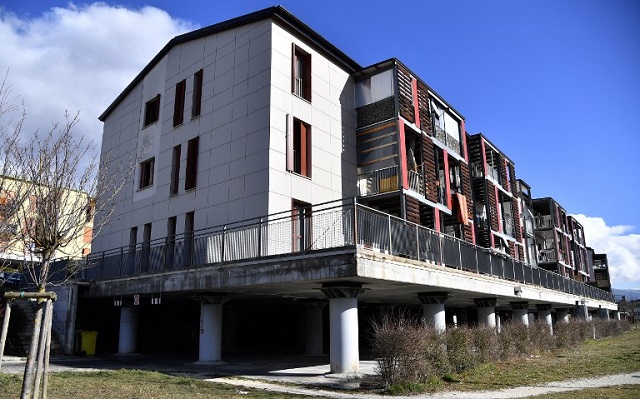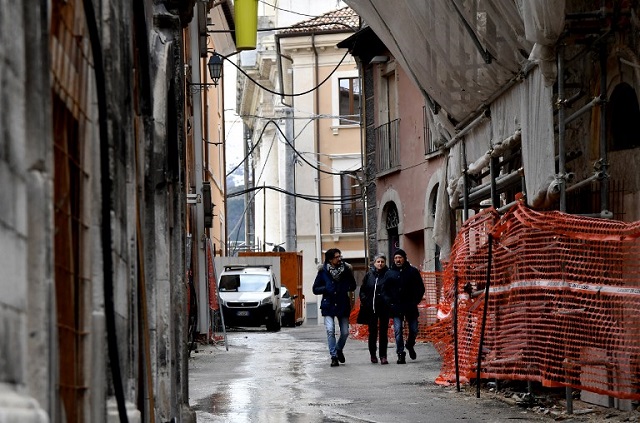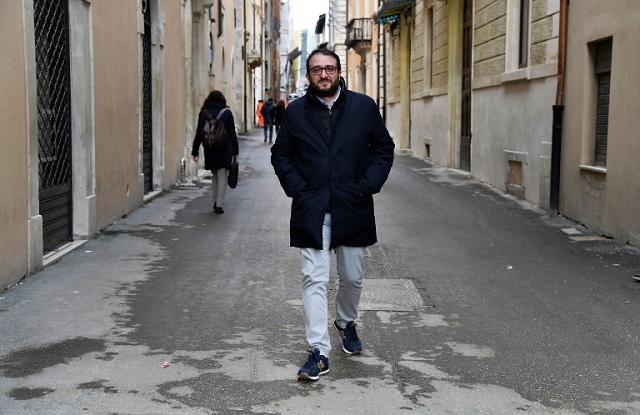Why many residents of quake-hit L'Aquila are still grateful to Berlusconi

Nearly nine years after a devastating earthquake, L'Aquila is still struggling to emerge from the rubble, but residents of the once stunning city thank Silvio Berlusconi for putting roofs over their heads.
Then-prime minister Berlusconi is now back in politics as the head of a centre-right coalition tipped to win the most votes in a March 4th poll. While many around Italy are sceptical about the billionaire media mogul's return, people here remember how, following the April 2009 quake that left more than 300 people dead, he moved quickly to build homes for many thousands left with nothing.
In September that year the first quake-resistant Progetto C.A.S.E. (meaning "homes project") apartment blocks were thrown up. By August 2010 they would offer shelter to around 15,000 people.
-
Italy's earthquake-hit towns are bidding for Unesco status
-
Seven years after the earthquake, what's life like in L'Aquila?
-
Italian court acquits engineer sentenced over quake deaths

Debris being removed in the town centre. Photo: Tiziana Fabi/AFP
Despite the fact that last year some families had to be evacuated due to structural problems, the speed with which Berlusconi's government moved in the wake of the tragedy has not been forgotten.
"I cried when I moved in here," says Pierluigi Lo Marco, standing outside the place he called home until May 2014.
'Roof over my head'
Lo Marco was among those, in the presence of Berlusconi in September 2009, to be given the first 400 homes in the Bazzano area, one of 19 new neighbourhoods placed effectively in the Abruzzo countryside.
There was some controversy over the speed with which the houses were built, while many suspected Berlusconi was merely after a popularity boost. Also, many of the houses were built in locations isolated from the rest of the city and left without maintenance.
READ ALSO: Which areas of Italy have the highest risk of earthquakes?

Housing in Bazzano. Photo: Tiziana Fabi/AFP
"Regardless I thank God that, whether for honest reasons or not, there was someone who put a roof over my head," Lo Marco adds. "You can't ignore that ... I'd be a hypocrite to do so."
Today more than 10,000 people still live in the homes built in the wake of the disaster. Lo Marco explains that they are largely people who are still waiting to return to their city centre homes and young couples who can't afford the rent elsewhere.
Workmen, diggers, cranes
Some are paying as little as 15 euros ($18) a month and have little incentive to move back onto the private housing market.
"Often ... the building work would be done, but in the meantime the tenant lost their job and couldn't pay the rent anymore," says Lo Marco. "So they've stayed here."
In the centre of L'Aquila workmen, diggers and cranes crowd the streets and dominate the skyline. The elegant buildings and squares -- which span the medieval, Renaissance and Baroque periods -- are beginning to take shape and restaurants and bars are open for business.
READ ALSO: A long history of destructive earthquakes in Italy

Photo: Tiziana Fabi/AFP
But local restorer Francesca Aloisio says: "Normal life hasn't come back to this city."
Aloisio is working to restore the facades on three buildings in central L'Aquila's "red zone" -- the area still considered unsafe. She points to the "spotty" way the rebuilding has been carried out since work began in the city centre in 2013 -- four years after the earthquake hit.
"Often a building is done but it's not connected to the water, gas or electricity," she says. "Or it's a white elephant surrounded by buildings propped up and others that need to be knocked down."
Middle class has fled
The other issue holding L'Aquila back is the lack of businesses other than the bars and restaurants. Family-run bakers and grocers, for instance, are conspicuous by their absence.
"Families are starting to return but we need to bring back the true city centre, that place where you can go on foot to school, the chemists, the bank and the post office," says Pierluigi Biondi, mayor of L'Aquila since July.

Mayor Pierluigi Biondi walks down a street in L'Aquila. Photo: Tiziana Fabi/AFP
Biondi is from the Brothers of Italy party, part of Berlusconi's coalition. He was mayor of nearby Villa Sant'Angelo when the earthquake hit, and laments the loss of the "productive middle class, without which the area becomes poorer".
He adds: "The elderly and the poor didn't leave L'Aquila -- it was the public sector workers who got themselves transferred, and the professionals who opened their business elsewhere."
'What are we building for?'
Paolo Muzi, president of the L'Aquila and regional Abruzzo branch of heritage organization Italia Nostra, says that "it's hard to live in the city centre these days."
"There's a huge amount of noise and dust from all the work going on, and many of the services essential to the life of a city have still not returned," says Muzi, a L'Aquila native.
"If we don't bring them back, then what are we rebuilding for?"
By Terry Daley
Comments
See Also
Then-prime minister Berlusconi is now back in politics as the head of a centre-right coalition tipped to win the most votes in a March 4th poll. While many around Italy are sceptical about the billionaire media mogul's return, people here remember how, following the April 2009 quake that left more than 300 people dead, he moved quickly to build homes for many thousands left with nothing.
In September that year the first quake-resistant Progetto C.A.S.E. (meaning "homes project") apartment blocks were thrown up. By August 2010 they would offer shelter to around 15,000 people.
- Italy's earthquake-hit towns are bidding for Unesco status
- Seven years after the earthquake, what's life like in L'Aquila?
- Italian court acquits engineer sentenced over quake deaths

Debris being removed in the town centre. Photo: Tiziana Fabi/AFP
Despite the fact that last year some families had to be evacuated due to structural problems, the speed with which Berlusconi's government moved in the wake of the tragedy has not been forgotten.
"I cried when I moved in here," says Pierluigi Lo Marco, standing outside the place he called home until May 2014.
'Roof over my head'
Lo Marco was among those, in the presence of Berlusconi in September 2009, to be given the first 400 homes in the Bazzano area, one of 19 new neighbourhoods placed effectively in the Abruzzo countryside.
There was some controversy over the speed with which the houses were built, while many suspected Berlusconi was merely after a popularity boost. Also, many of the houses were built in locations isolated from the rest of the city and left without maintenance.
READ ALSO: Which areas of Italy have the highest risk of earthquakes?

Housing in Bazzano. Photo: Tiziana Fabi/AFP
"Regardless I thank God that, whether for honest reasons or not, there was someone who put a roof over my head," Lo Marco adds. "You can't ignore that ... I'd be a hypocrite to do so."
Today more than 10,000 people still live in the homes built in the wake of the disaster. Lo Marco explains that they are largely people who are still waiting to return to their city centre homes and young couples who can't afford the rent elsewhere.
Workmen, diggers, cranes
Some are paying as little as 15 euros ($18) a month and have little incentive to move back onto the private housing market.
"Often ... the building work would be done, but in the meantime the tenant lost their job and couldn't pay the rent anymore," says Lo Marco. "So they've stayed here."
In the centre of L'Aquila workmen, diggers and cranes crowd the streets and dominate the skyline. The elegant buildings and squares -- which span the medieval, Renaissance and Baroque periods -- are beginning to take shape and restaurants and bars are open for business.
READ ALSO: A long history of destructive earthquakes in Italy

Photo: Tiziana Fabi/AFP
But local restorer Francesca Aloisio says: "Normal life hasn't come back to this city."
Aloisio is working to restore the facades on three buildings in central L'Aquila's "red zone" -- the area still considered unsafe. She points to the "spotty" way the rebuilding has been carried out since work began in the city centre in 2013 -- four years after the earthquake hit.
"Often a building is done but it's not connected to the water, gas or electricity," she says. "Or it's a white elephant surrounded by buildings propped up and others that need to be knocked down."
Middle class has fled
The other issue holding L'Aquila back is the lack of businesses other than the bars and restaurants. Family-run bakers and grocers, for instance, are conspicuous by their absence.
"Families are starting to return but we need to bring back the true city centre, that place where you can go on foot to school, the chemists, the bank and the post office," says Pierluigi Biondi, mayor of L'Aquila since July.

Mayor Pierluigi Biondi walks down a street in L'Aquila. Photo: Tiziana Fabi/AFP
Biondi is from the Brothers of Italy party, part of Berlusconi's coalition. He was mayor of nearby Villa Sant'Angelo when the earthquake hit, and laments the loss of the "productive middle class, without which the area becomes poorer".
He adds: "The elderly and the poor didn't leave L'Aquila -- it was the public sector workers who got themselves transferred, and the professionals who opened their business elsewhere."
'What are we building for?'
Paolo Muzi, president of the L'Aquila and regional Abruzzo branch of heritage organization Italia Nostra, says that "it's hard to live in the city centre these days."
"There's a huge amount of noise and dust from all the work going on, and many of the services essential to the life of a city have still not returned," says Muzi, a L'Aquila native.
"If we don't bring them back, then what are we rebuilding for?"
By Terry Daley
Join the conversation in our comments section below. Share your own views and experience and if you have a question or suggestion for our journalists then email us at [email protected].
Please keep comments civil, constructive and on topic – and make sure to read our terms of use before getting involved.
Please log in here to leave a comment.